Episodes
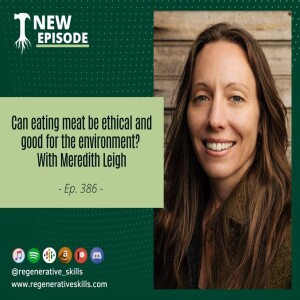
33 minutes ago
33 minutes ago
I had the pleasure of speaking to Meredith Leigh, the author of “The Ethical Meat Handbook.” Meredith has worked as a farmer, butcher, chef, teacher, non-profit executive director, consultant, and writer for the past 17 years, all in the pursuit of sustainable food
The industrial meat industry, in my opinion, is the epitome of what is broken in our food system and is a glaring example of the disconnect between humans and healthy natural systems, but Meredith shows us how we can reconnect with animals by treating every step in the process from raising, to slaughter, butchery and cooking with respect and care. In this interview we start by acknowledging the broken and unhealthy state of meat consumption. We also go in depth about the environmental impacts, issues surrounding animal welfare, and the health problems of an imbalanced diet. Meredith then explains how a healthy and reverent relationship to animals and all their products could look like through real examples of ecological management of livestock systems, mindful slaughter, home butchery methods, and preservation through curing, fermentation and cooking. This is one of the most holistic and nuanced perspectives on every aspect of meat that I’ve come across that even treats vegan and vegetarian perspectives on the topic with compassion and understanding. Meredith herself was vegan before getting involved with butchery and animal care so I encourage you to listen through the full episode before jumping to conclusions on the angle that this interview takes.
I also recognize that everything about meat from animal care, to diet, slaughter and cooking are very contentious topics at the moment and I would love to hear from you about how you feel and relate to the opinions expressed in this session, so please leave respectful comments and feedback under the show notes for this episode, or any other episode for that matter
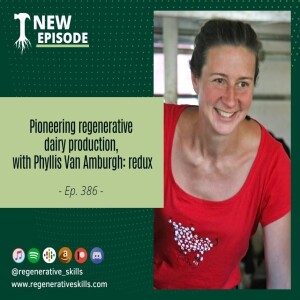
Friday Jul 11, 2025
Friday Jul 11, 2025
At this point I’ve covered a wide array of practices and management styles that fall under the broad umbrella of regenerative agriculture. Some could be considered traditional while others are more modern and innovative and they span continents, climates, biomes and industries. Nonetheless I’ve noticed a pretty big gap that I’ve yet to cover in detail that I hope to begin to fill in today.
Dairy farming has been under sharp criticism in recent times. Scrutiny over everything from the appropriateness of dairy in the diet to the methane emissions of cows and the controversial practices of early separation of calves from their mothers to maximize milk production have all contributed to a diminished reputation.
Though these critiques are very legitimate, what if there were solutions to all of them without the need to turn to non-dairy alternatives?
Today to explore these solutions is one of the leaders in regenerative dairy and a growing movement of dairy producers working to develop a new way of managing dairy cows and the pastures they coexist with. Phyllis Van Amburgh along with her husband Paul and their family are leaders in holistic land use, biodiverse cultivation, Organic dairy herd management, and more.
Together they are dairy farmers in upstate New York, and have been involved in key innovations in the dairy industry, mostly in western parts of the world, re-integrating dairy cows as a cornerstone for ecological health and for human communities to thrive. Phyllis and Paul have also helped develop the Grass-fed certification program with NOFA-NY and PCO.
In this interview Phyllis starts by sharing her inspiring story of transitioning away from her previous career as she and Paul embraced a gradual move into full time farming.
We explore the intuition she had that much of the conventional wisdom and ways of doing things in the dairy industry were not really in the interest of either the cows nor the farmers and how that led them to rethink their own dairy operation.
Phyllis outlines the key aspects they consider essential for managing a dairy herd regeneratively and the pioneering journey they’re on to make exclusively grass fed dairy cows viable through selective breeding and holistic managed grazing.
We also explore Phyllis’ insights from her work helping large dairy operations in the USA and Europe to transition to regenerative management and the challenges and opportunities that the wider industry has to transform.
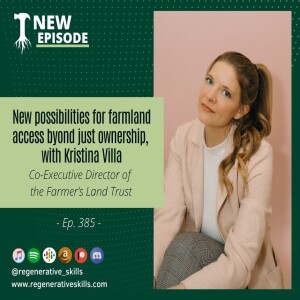
Friday Jul 04, 2025
Friday Jul 04, 2025
Since I’ve been working in the regenerative agriculture and ecosystem restoration sector for about a decade now, there are a number of subjects and questions that keep coming up again and again. Everything from How to finance a regenerative transition, What initial steps to take to accelerate ecosystem restoration, and the big one, How can I get access to land. Anyone who has been in this space for any time knows that land access has become one of the biggest hurdles for people who are motivated to start farming, regardless of the enterprise or practices they want to start. Even people who come from landed families face difficulties in transferring land ownership in a way that doesn’t saddle the recipient with debt. The fact that land has become a financial commodity and the demand from developers and speculators has all contributed to soaring prices and predatory loan conditions too. Yet there are alternatives, and that’s exactly what we’re going to explore in this episode where I’ll be speaking with Kristina Villa.
Kristina is the co-executive director of the Farmer's Land Trust, a farmer, communicator, and community coordinator who believes that our connection to the soil is directly related to the health of our bodies, economy, and society. With over a decade of farming, communication, and fundraising experience, Kristina enjoys using her skill sets to share photos, stories, and information in engaging ways which help to inspire change in human habits and mindsets, causing the food system, climate, and overall well-being of the world to improve. Kristina has spent the last several years of her professional career saving farmland from development and securing it in nonprofit land holding structures that give farmers, stewards and ranchers long-term and affordable access and tenure to it. Most of her work in the land access space has focused on equitable land security for BIPOC growers, addressing the inequities and disparities in how land is owned and accessed in this country.In this episode we cover the vast topic of land access, while touching on the history of land privatization and how so many groups of people have been systematically removed from land access, how land has become increasingly unobtainable, especially for farmers, traditional models of common land access and how the farmland commons offers a modern legal template for equitable land access for farmers in the modern context.We really take the time to go into specifics here as we explore case studies of non-profits that have setup farmland commons in their communities, how those legal entities are organized and maintained, and how the basic structure can be adapted to the unique needs and focus of the communities that they serve. This is a very important topic for anyone interested in non-conventional paths to farmland access and tenureship, but also for those who might be considering retirement from their own farm and are motivated to enable a legacy of stewardship on their farm rather than selling the landbase itself.Learn more at thefarmerslandtrust.org
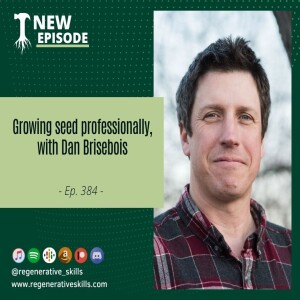
Saturday Jun 21, 2025
Saturday Jun 21, 2025
I’ve explored the topic of seed saving and breeding a number of times in previous episodes and it’s become such a passion of mine that it’s the primary focus of my early work here on my own farm as I begin to get the main patterns and infrastructure developed. A new angle of this subject however is the more direct and professional operation of producing seed to sell. This requires even more planning and coordination as each plant has its own peculiarities of reproduction and conditions for harvest, processing, and preservation. Luckily I’ve got a seasoned veteran of seed production to illuminate the key considerations and preparations to build a successful seed production enterprise, including on top of an existing market garden.
In this conversation I’ve got Dan Brisebois, a seasoned cooperative farmer, to discuss the various aspects of seed farming, from his own slow start in the beginning, to the present day success of his enterprise that was founded in 2004. He starts by touching on his background and his shift from agricultural engineering to farming, driven by a passion discovered during summer farm work. Dan elaborates on his cooperative farm’s structure, which has expanded to include 11 members and 9 member applicants. He then delves into his journey of integrating seed production into his market gardening enterprise, spurred by encounters with seed enthusiasts and the fascination with cross-pollination and plant breeding. Dan also shares practical insights on the equipment, processes, and considerations for seed harvesting, cleaning, and storage, emphasizing the importance of knowledge over technological sophistication. He explains his labeling and tracking system for plant breeding and offers advice on balancing genetic diversity with achieving true-to-type consistency. Furthermore, Dan reflects on the unexpected discoveries and rewarding moments in plant breeding and highlights the profitability factors when growing seeds for bulk versus small packets. Lastly, Dan touches on the impact of market demand for specialty seeds and advises aspiring seed growers on where to get started, mentioning his book, podcast, and additional resources provided through his Farmer Spreadsheet Academy.For those of you like me, passionate about the unlimited potential of working with seed, or who perhaps already have a garden or market veggie production enterprise and might want to add some additional value to what you’re already growing, this will be a great episode for you.
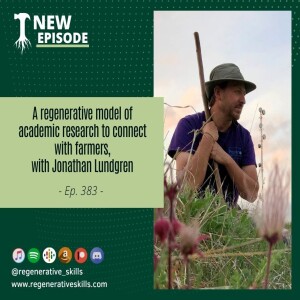
Friday Jun 13, 2025
Friday Jun 13, 2025
There often seems to be an unfortunate disconnect between farmers in the field and the researchers and academics involved with agronomic study. I often hear in the discussions in the climate farmers community about how academic studies don’t reflect the reality in the field, or that the ivory tower of academia is out of touch with the farms and situations they study. As I've made more connections in universities and research programs, I find that academics are aware of this too and are concerned about this lack of communication and the barriers between these sections of the industry that should be in closer collaboration. I’ve often wondered what an integrally connected research sector and farm culture could look like. Would researchers be a regular presence in the field and rural communities with close friendships and collaborations with farm owners and workers alike? Would this mean more farmers conducting their own studies and experiments and sharing the findings with universities and peers as they receive guidance and recognition for their contributions?Maybe a journeyman farmer trade apprenticeship could include research and experimentation training as well as communications of findings and a more holistic approach to farm study.The good news is that many of these ideas are not that far fetched and are being explored in various ways by Dr. Jonathan Lundgren who is an agroecologist, beekeeper, farmer, Executive Director of Ecdysis Foundation, and CEO for Blue Dasher Farm. Lundgren’s research and education programs are helping applied science evolve in ways that foster the evolution of a regenerative food system. He regularly interacts with the public and farmers around the world regarding ecologically intensive farming and how biodiversity fuels the resilience and productivity of an agroecosystem and rural communities.In this episode Jonathan shares his journey from being a suburban biology enthusiast turned USDA scientist, to becoming a farmer and regenerative scientific researcher. We discuss the challenges and successes of managing a diverse farm at Blue Dasher Farm, which integrates native prairie, wetlands, and various crops and animals. Jonathan emphasizes the importance of biodiversity, community, and the limitations of conventional scientific metrics in truly understanding and enhancing agricultural systems. He also describes his innovative approaches to research, focusing on real-world data collection from thousands of farms, and advocating for a more relational and context-specific approach to both farming and science.
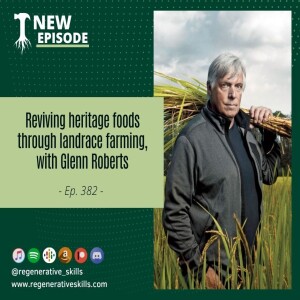
Saturday Jun 07, 2025
Saturday Jun 07, 2025
Join Oliver on Regenerative Skills as he interviews Glenn Roberts of Anson Mills, exploring the revival of heritage cultivars like Carolina Gold Rice. Discover how deep-rooted, sustainable agricultural practices and community engagement are transforming the modern food system. Learn about the importance of landrace genetics, polyculture, and the potential of crops to adapt to climate change. Glenn shares his journey, the influence of early mentors, and how chefs and local communities are embracing this movement towards more resilient and flavorful food.
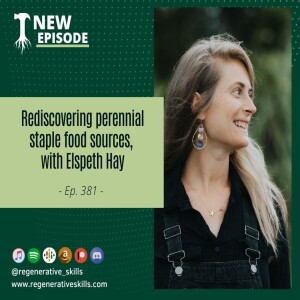
Friday May 30, 2025
Friday May 30, 2025
As I continue to advance the tree and perennial food nursery here at my farm, I’m always on the lookout for new resources on anything about growing and breeding perennial food sources, the history of their cultivation, and the cultures that were and are connected to these woodland and orchard based staple foods. For that reason I was super excited to see the new title “Feed us with Trees” from my friends at New Society Publishers, by author Elspeth Hay.
Elspeth is a writer, public radio host, and creator of the Local Food Report, a weekly feature that has aired on CAI, the Cape & Islands NPR Station, since 2008. Deeply immersed in her own local food system, she writes and reports for print, radio, and online media with a focus on food and the environment. Elspeth’s work has been featured in the Boston Globe, NPR’s Kitchen Window, Heated with Mark Bittman, The Provincetown Independent, and numerous other publications. Through her conversations with growers, harvesters, processors, cooks, policy makers, Indigenous knowledge-keepers, scientists, researchers, and visionaries, she aims to rebuild our cultural store of culinary knowledge—and to reconnect us with the people, places, and ideas that feed us.
In this session, Elspeth shares her journey of developing a passion for perennial food systems, particularly focusing on nuts and tree-based staple crops.
Her early exposure to nature evolved into an obsession with acorns and other tree nuts. Her research went on to reveal the extensive use of tree nuts as staple foods across the northern hemisphere and the historical as well as the cultural shifts that led to their decline in favor of annual grain crops. Elspeth delves into the nutritional and ecological benefits of these perennial foods, the complexities of modern industrial agriculture, and the resurgence of interest in tree crops, especially in the American Midwest. She also explores innovative recipes and culinary uses of nuts, especially acorns and chestnuts, while emphasizing the importance of integrating perennial crop systems into modern diets and agricultural practices. This conversation covers a lot of ground from land management, economic models, and the promising future of perennial food systems.
As with all the books that I focus on from my friends at new society publishers, we’re running a book giveaway for “Feed us with Trees.” By now you know the drill. Send me a message on our Discord community. If you’re not already a member you can sign up through the links on our homepage or the bio on Instagram. I’ll choose a winner one week after this episode goes live, and If you live anywhere in North America we’ll send a physical copy. Everywhere else you’ll receive a digital version.
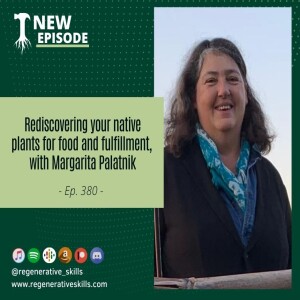
Friday May 23, 2025
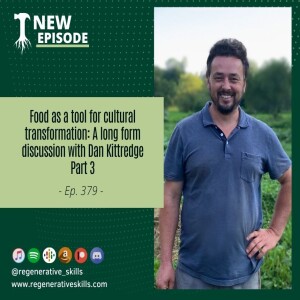
Friday May 16, 2025
Friday May 16, 2025
Welcome to the last portion of our long form discussion with Dan Kittredge.
In this last third we navigate the need for Generational Healing and Cultural Shifts in our collective culture. The unavoidable reality that the healthiest food for you as an individual can never be bought. Steps for building resilience and Self-Sufficiency, before then going back to Dan’s own Journey to Farming and interest in Nutrient Density as well as his current Challenges and plans for the future.
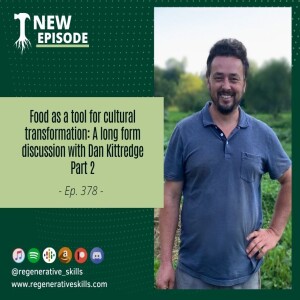
Friday May 09, 2025
Friday May 09, 2025
Today we’ll be continuing with the second portion of our long form discussion with Dan Kittredge. In this second third we mostly get into Principles of Biological Systems and how to apply Nature's Patterns in Business. Dan talks about his experience Engaging with Farmers and Large Businesses alike. We dig into his personal Journey, the influence that Eastern Paradigms and Consciousness have had on his world view, the connection of Nutrient Density and Spirituality, and the potential of Technological Tools to be transformed for Empowerment.









